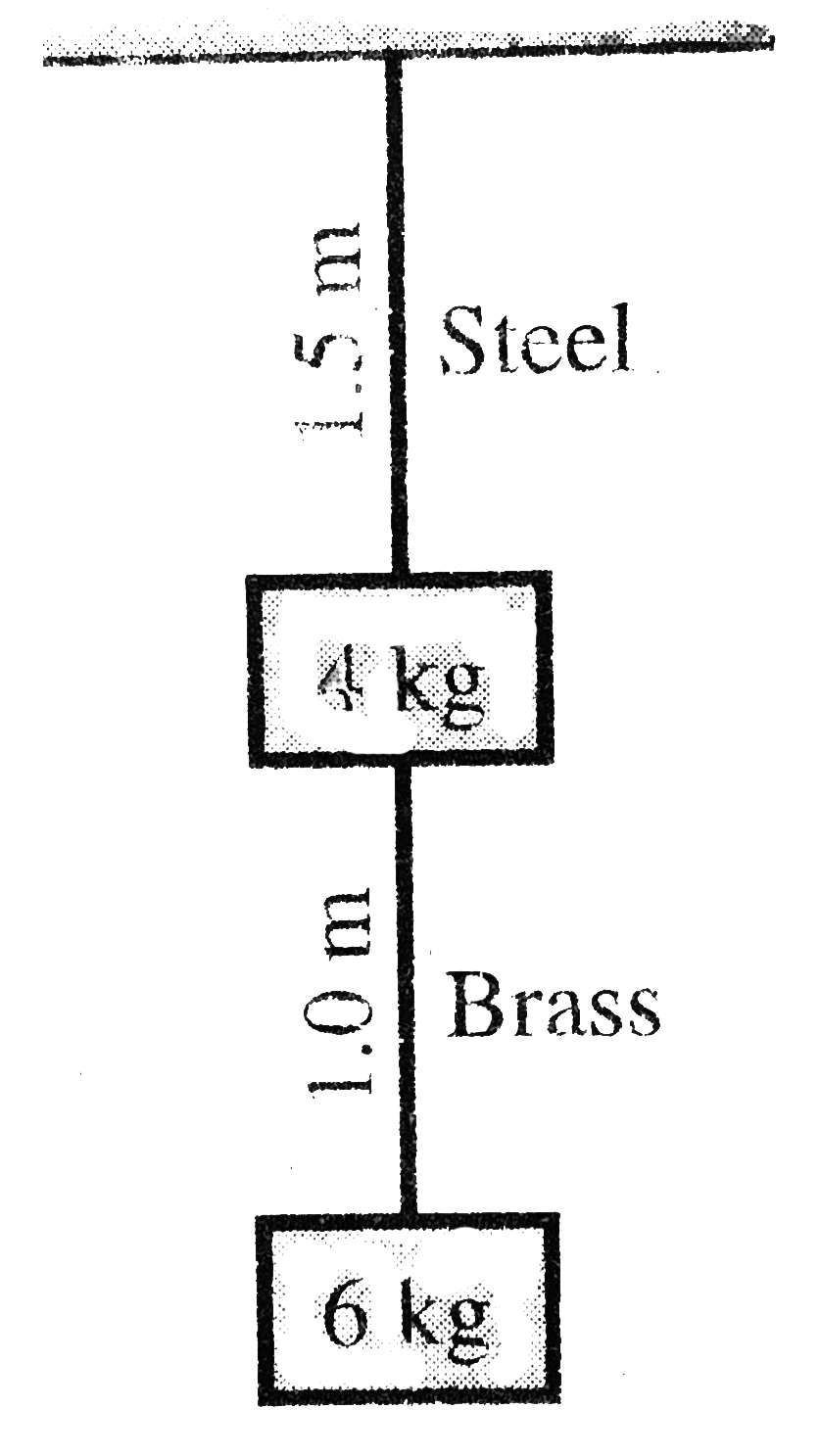A composite wire of uniform diameter 3mm consisting of copper wire of length 2.2 m and a steel wire of length 1. 6m stretches under a load by 0.7mm. Calcualte the load, given that the Young's modulus of copper is 1.1×1011Pa and for steel is 2.0×1011Pa.
To solve the problem step by step, we will follow the principles of Young's modulus and the properties of composite materials.
Step 1: Understand the given data
- Diameter of the wire, d=3mm=3×10−3m
- Radius of the wire, r=d2=1.5×10−3m
- Length of copper wire, Lc=2.2m
- Length of steel wire, Ls=1.6m
- Total extension, ΔLtotal=0.7mm=0.7×10−3m
- Young's modulus of copper, Yc=1.1×1011Pa
- Young's modulus of steel, Ys=2.0×1011Pa
Step 2: Calculate the cross-sectional area of the wire
The area A of the wire can be calculated using the formula for the area of a circle:
A=πr2=π(1.5×10−3)2=π×2.25×10−6m2
Calculating this gives:
A≈7.06858×10−6m2
Step 3: Relate the total extension to the extensions of copper and steel
The total extension is the sum of the extensions of the copper and steel wires:
ΔLtotal=ΔLc+ΔLs
Using the formula for extension due to a load:
ΔL=FLAY
We can express the extensions for copper and steel:
ΔLc=FLcAYc
ΔLs=FLsAYs
Thus, we can write:
ΔLtotal=FLcAYc+FLsAYs
Step 4: Factor out the common terms
Factoring out F and A:
ΔLtotal=F(LcAYc+LsAYs)
This can be rearranged to find F:
F=ΔLtotalALcYc+LsYs
Step 5: Substitute the values
Substituting the known values into the equation:
F=0.7×10−3×7.06858×10−62.21.1×1011+1.62.0×1011
Calculating the denominator:
2.21.1×1011=2.0×10−11
1.62.0×1011=0.8×10−11
Thus,
LcYc+LsYs=2.0×10−11+0.8×10−11=2.8×10−11
Step 6: Final calculation
Now substituting back into the equation for F:
F=0.7×10−3×7.06858×10−62.8×10−11
Calculating F:
F≈4.947×10−92.8×10−11≈176.62N
Final Answer
The load F is approximately 176.62N.
---
- Diameter of the wire, d=3mm=3×10−3m
- Radius of the wire, r=d2=1.5×10−3m
- Length of copper wire, Lc=2.2m
- Length of steel wire, Ls=1.6m
- Total extension, ΔLtotal=0.7mm=0.7×10−3m
- Young's modulus of copper, Yc=1.1×1011Pa
- Young's modulus of steel, Ys=2.0×1011Pa
The area A of the wire can be calculated using the formula for the area of a circle:
A=πr2=π(1.5×10−3)2=π×2.25×10−6m2
Calculating this gives:
A≈7.06858×10−6m2
The total extension is the sum of the extensions of the copper and steel wires:
ΔLtotal=ΔLc+ΔLs
Using the formula for extension due to a load:
ΔL=FLAY
We can express the extensions for copper and steel:
ΔLc=FLcAYc
ΔLs=FLsAYs
Thus, we can write:
ΔLtotal=FLcAYc+FLsAYs
Factoring out F and A:
ΔLtotal=F(LcAYc+LsAYs)
This can be rearranged to find F:
F=ΔLtotalALcYc+LsYs
Substituting the known values into the equation:
F=0.7×10−3×7.06858×10−62.21.1×1011+1.62.0×1011
Calculating the denominator:
2.21.1×1011=2.0×10−11
1.62.0×1011=0.8×10−11
Thus,
LcYc+LsYs=2.0×10−11+0.8×10−11=2.8×10−11
Now substituting back into the equation for F:
F=0.7×10−3×7.06858×10−62.8×10−11
Calculating F:
F≈4.947×10−92.8×10−11≈176.62N
The load F is approximately 176.62N.
Topper's Solved these Questions
- BOOK - ICSECHAPTER - PROPERTIES OF MATTEREXERCISE - MODULE 2 (SOLVED EXAMPLES)22videos
PROPERTIES OF MATTER
- BOOK - ICSECHAPTER - PROPERTIES OF MATTEREXERCISE - MODULE 3 (SOLVED EXAMPLES)31videos
PROPERTIES OF MATTER
- BOOK - ICSECHAPTER - OSCILLATIONS EXERCISE - SELECTED PROBLEMS (OSCILLATION IN A TUNNEL BORED THROUGH THE EARTH)2videos
OSCILLATIONS
- BOOK - ICSECHAPTER - SAMPLE QUESTION PAPER - 01 EXERCISE - SECTION - D12videos
SAMPLE QUESTION PAPER - 01
Similar Questions
A steel wire of length 600cm and diameter 1.2 mm is stretched through 4 mm by a load. Calculate the work done. Young's modulus of steel =2×1011Nm−2.
View SolutionA Copper wire of length 2.2m and a steel wire of length 1.6m, both of diameter 3.0mm are connected end to end. When stretched by a load, the net elongation is found to be 0.70 mm. Obtain the load applied . Young's modulus of copper is 1.1×1011Nm−2 and Young's modulus of steel is 2.0×1011Nm−2.
View Solution
Knowledge Check
- Question 1 - Select One
A copper wire of length 2.4 m and a steel wire of length 1.6 m, both of diameter 3 mm, are connected end to end. When stretched by a load, the net elongation found to be 0.7 mm. The load appled is
(YCopper=1.2×1011Nm−2,Ysteel=2×1011Nm−2)A1.2×102NB1.8×102NC2.4×102ND3.2×102N
Young 's modulus of steel is 2.0×1011Nm/(2). Express it is dynecm2.
View SolutionA steel wire of length 4 m and diameter 5 mm is stretched by 5kg-wt. Find the increase in its length if the Young's modulus of steel wire is 2.4×1012dynecm−2
View SolutionA steel wire of length 4 m and diameter 5 mm is strethed by 5 kg-wt. Find the increase in its length, if the Young's modulus of steel is 2×1012 dyne cm2
View SolutionA wire of length 15m and diameter 4 mm elongates 0.3mm when stretched by weigth of 2.20kg. Calulate the Young's modulus of the material of the wire.
View SolutionTwo wires of diameter 0.25cm, one made of steel and other made of brass, are loaded as shown in the figure. The unloaded length of the steel wire is 1.5m and that of brass is 1.0m. Young's modulus of steel is 2.0×1011Pa and that of brass is 1.0×1011 Pa. Compute the ratio of elongations of steel and brass wires. △lsteel△lbrass=?
 View Solution
View Solution(a) A wire 4m long and 0.3 mm, calculate the potential energy stored in the wire.
Young's modulus for the material of wire is 2.0×1011N/m2.View SolutionThe area of cross-section of a wire of length 1.1 meter is 1mm2. It is loaded with 1 kg. if young's modulus of copper is 1.1×1011N/m2 then the increase in length will be (if g=10m/s2)-
View Solution

